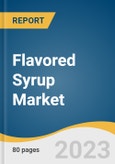The global flavored syrup market size is expected to reach USD 70.16 billion by 2030, registering a CAGR of 3.6% during the forecast period. The use of flavored syrups as a flavor and sweetness enhancer is gaining popularity among manufacturers in the food and beverage industries. The growing demand for customized flavors in the beverage and food industries is further driving the market.
Flavored syrups are organic or natural add-ons that sweeten and enhance the flavor of food products such as cocktails, cold drinks, and a variety of beverages. Consumers nowadays have a choice to pick from a wide variety of low-calorie syrups without jeopardizing their health. The widespread availability of a wide range of personalized flavors also boosts market demand. The increased preference for organic and natural products will provide brands with opportunities to innovate in the coming years.
The market benefits from the burgeoning dairy industry globally, especially in Asia Pacific, due to the increased consumption of flavored milk, milkshakes, yogurts, smoothies, frappes, and whipped cream. In the coming years, the frozen desserts industry will become profitable, which may well support the market growth, because these serve as toppings, adding a savory flavor to the desserts.
The constant spike in urbanization in emerging economies has drastically altered people's consumption patterns. As a result, more international cuisines are appearing on various occasions as part of celebrations or weekend hangouts. This has also resulted in the considerable expansion of hotel and restaurant chains in tier-1 and tier-2 cities in developing nations. All of these developments have had a favorable impact on the supply chain. Therefore, as a result, flavored syrups are becoming popular in hotels and restaurants in developing economies, which may propel the market growth during the projected timeframe.
Flavored syrups are extremely popular in Western countries such as Canada, the U.K., Germany, France, and the U.S. These syrups are primarily used as a topping in ice cream, pancakes, waffles, desserts, ready-to-eat food products, and various breakfast foods. High consumption and production of these products in the aforementioned countries have significantly contributed to the global market growth. Furthermore, the market is expected to be driven by rising demand for chocolate-flavored syrups for various bakery and confectionery products and cold beverages in the coming years.
Flavored syrups are organic or natural add-ons that sweeten and enhance the flavor of food products such as cocktails, cold drinks, and a variety of beverages. Consumers nowadays have a choice to pick from a wide variety of low-calorie syrups without jeopardizing their health. The widespread availability of a wide range of personalized flavors also boosts market demand. The increased preference for organic and natural products will provide brands with opportunities to innovate in the coming years.
The market benefits from the burgeoning dairy industry globally, especially in Asia Pacific, due to the increased consumption of flavored milk, milkshakes, yogurts, smoothies, frappes, and whipped cream. In the coming years, the frozen desserts industry will become profitable, which may well support the market growth, because these serve as toppings, adding a savory flavor to the desserts.
The constant spike in urbanization in emerging economies has drastically altered people's consumption patterns. As a result, more international cuisines are appearing on various occasions as part of celebrations or weekend hangouts. This has also resulted in the considerable expansion of hotel and restaurant chains in tier-1 and tier-2 cities in developing nations. All of these developments have had a favorable impact on the supply chain. Therefore, as a result, flavored syrups are becoming popular in hotels and restaurants in developing economies, which may propel the market growth during the projected timeframe.
Flavored syrups are extremely popular in Western countries such as Canada, the U.K., Germany, France, and the U.S. These syrups are primarily used as a topping in ice cream, pancakes, waffles, desserts, ready-to-eat food products, and various breakfast foods. High consumption and production of these products in the aforementioned countries have significantly contributed to the global market growth. Furthermore, the market is expected to be driven by rising demand for chocolate-flavored syrups for various bakery and confectionery products and cold beverages in the coming years.
Flavored Syrup Market Report Highlights
- By product, chocolate is expected to witness the fastest growth during the forecast period owing to the rising use of chocolate syrups in commercial applications in the manufacturing of chocolates, dairy products, bakeries, ice creams, and frozen desserts
- In terms of distribution channel, the B2B segment dominated the global market in 2022 due to the increasing use of flavored syrups as sweeteners and flavor enhancers in both hot and cold beverages
- Asia Pacific is projected to register the highest CAGR in the forecast period owing to high product demand and developments in countries such as India and China
Table of Contents
Chapter 1. Methodology and Scope
Chapter 2. Executive Summary
Chapter 3. Flavored Syrup Market Variables, Trends & Scope
Chapter 4. Consumer Behavior Analysis
Chapter 5. Flavored Syrup Market: Product Estimates & Trend Analysis
Chapter 6. Flavored Syrup Market: Distribution Channel Estimates & Trend Analysis
Chapter 7. Flavored Syrup Market: Regional Estimates & Trend Analysis
Chapter 8. Competitive Analysis
List of Tables
List of Figures
Companies Mentioned
- The Hershey Company
- The Kraft Heinz Company
- Kerry Group
- Tate & Lyle
- Toschi Vignola S.R.L.
- Monin Inc.
- Fuerst Day Lawson
- Torani
- The J.M. Smucker Company
- Panos Brands
- Amoretti
- Skinny Mixes
- Nature's Flavors, Inc.
- Sonoma Syrup Co.
Methodology

LOADING...
Table Information
| Report Attribute | Details |
|---|---|
| No. of Pages | 80 |
| Published | July 2023 |
| Forecast Period | 2022 - 2030 |
| Estimated Market Value ( USD | $ 52.68 billion |
| Forecasted Market Value ( USD | $ 70.16 billion |
| Compound Annual Growth Rate | 3.6% |
| Regions Covered | Global |
| No. of Companies Mentioned | 14 |









